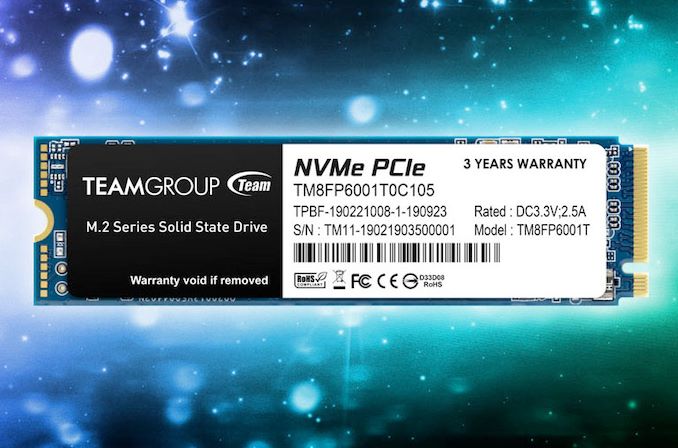Team Group Unveils MP33 SSDs: Entry-Level PCIe Drives
by Anton Shilov on October 3, 2019 11:00 AM EST- Posted in
- SSDs
- Storage
- Phison
- Silicon Motion
- 3D TLC
- Team Group
- SM2263XT
- PS5013-E13T

Team Group has introduced its new family of NVMe SSDs aimed at the budget PC market. The new MP33 drives use controllers from Silicon Motion and Phison and will be available in 128 GB, 256 GB, 512 GB, and 1 TB configuration.
Team Group’s MP33 SSDs are based on Silicon Motion’s SM2263XT or Phison PS5013-E13T controller as well as 3D TLC NAND memory from Intel or Toshiba. Using different controllers and memory from different suppliers within one family of drives enables the manufacturer to offer the most competitive prices for all configurations, however the actual performance is likely to differ, making this a difficult product to qualify as users will never know which configuration they are buying.
The MP33 drives from Team Group come in the M.2-2280 form-factor and feature a PCIe 3.0 x4 interface. When it comes to performance, the SSDs feature up to 1800 MB/s sequential read speed, up to 1500 MB/s sequential write speed, up to 220K random read IOPS, as well as up to 200K random write IOPS.
| Team Group MP33 SSD Specifications | ||||
| Capacity | 128 GB | 256 GB | 512 GB | 1 TB |
| Model Number | TM8FP6128G0C101 | TM8FP6256G0C101 | TM8FP6512G0C101 | TM8FP6001T0C101 |
| Controller | Silicon Motion SM2263XT Phison PS5013-E13T |
|||
| NAND Flash | 3D TLC NAND from Intel or Toshiba | |||
| Form-Factor, Interface | M.2-2280, PCIe 3.0 x4, NVMe 1.3 | |||
| Sequential Read | 1500 MB/s | 1600 MB/s | 1700 MB/s | 1800 MB/s |
| Sequential Write | 500 MB/s | 1000 MB/s | 1400 MB/s | 1500 MB/s |
| Random Read IOPS | 90K | 160K | 220K | 220K |
| Random Write IOPS | 100K | 200K | 200K | 200K |
| Pseudo-SLC Caching | Supported | |||
| DRAM Buffer | No | |||
| TCG Opal Encryption | ? | |||
| Power Management | ? | |||
| Warranty | ? years | |||
| MTBF | ? | |||
| TBW | 100 TB | 200 TB | 400 TB | 600 TB |
| Additional Information | Link | |||
| MSRP | ? | ? | ? | ? |
Since the MP33 SSDs do not feature any heat spreader, they can be installed inside desktops and laptops. Team Group’s MP33 SSDs will be available in the near future from the company’s retail partners. Pricing will depend on exact configuration, but we expect the drives to be priced very competitively.
Related Reading
- Dressed to Impress: Team Group’s T-Force Delta Max RGB SATA SSD
- Team Group’s T-Force Cardea Liquid: A Liquid-Cooled M.2 SSD
- The Team Group Delta RGB SSD Review: Lite Performance, Light Drive
Source: Team Group










10 Comments
View All Comments
DanNeely - Thursday, October 3, 2019 - link
Those performance numbers are modest enough I'm surprised they didn't go PCIe x2 for lower cost/power.kpb321 - Thursday, October 3, 2019 - link
Offhand I'd guess that they use the Host Memory Buffer feature like a lot of low end NVMe drives and so the extra PCIe bandwidth is helpful for accessing the system memory that it is using instead of having memory on the drive.Grayswean - Thursday, October 3, 2019 - link
x2 would be fine on PCIe 3.0, but would limit speed on older PCIe 2.0 machines, were x4 would not.Samus - Thursday, October 3, 2019 - link
What platforms after Haswell have been PCIe 2.0?iranterres - Thursday, October 3, 2019 - link
You cannot say a product is "entry level" without its MSRP. Damn click catching articles.goatfajitas - Thursday, October 3, 2019 - link
Exactly... When talking about an "entry level" product the price should be mandatory. Assuming these are priced a good deal less than say Samsung 970 EVO plus, they will do great for any normal user.ballsystemlord - Thursday, October 3, 2019 - link
So, if it's not priced at the entry level then you would say it's an entry level performer with mid tier pricing? Or would you say it's a mid tier product and we all suffer with the confusion?I'm of the opinion that AT made the right call here. It's an entry level performer.
shabby - Thursday, October 3, 2019 - link
No 64gb drive?DanNeely - Thursday, October 3, 2019 - link
modern flash dies are too small. Lack of parallelism kills performance. You can see that with the 128's perf being well below the 256 and larger. Higher performing families increasingly don't include 128 either for that reason.curry629 - Tuesday, November 26, 2019 - link
Two controllers? SM2263XT and PS5013? If I want a MP33 with PS5013 controller, How can I mare sure?